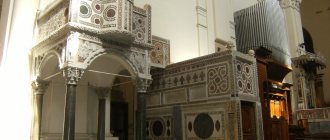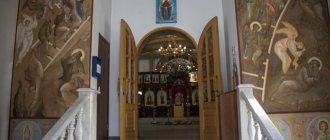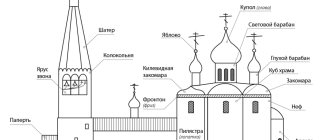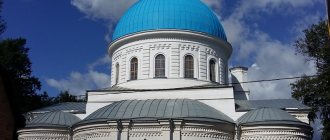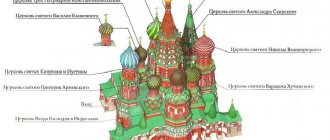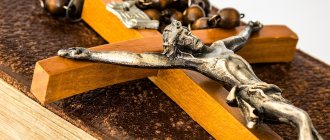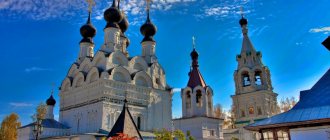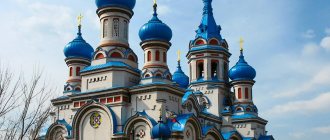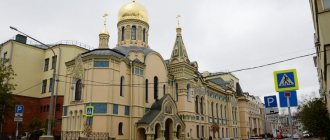Even in ancient times, a special place where sacrifices were constantly made to the Lord was called an altar. If we talk about what kind of symbol the altar is in the space of the temple, then it is worth saying that it symbolizes Paradise. The main element of the church altar is the Holy Altar, since it is on it that the clergyman performs the most important Sacrament of the Church - the Eucharist.
Photo: Sobory.ru
Having paid attention to the church altar, it is immediately worth saying that it consists of several parts, each of which has its own special, important meaning. In order to clearly understand the significance of each part of the altar and what an altar in general is in the Orthodox Church, this topic should be discussed in more detail.
Description of the parts of the altar and the meaning of each of them
Photo: Foma.ru
Each altar located inside an Orthodox church consists of a high place, the Holy Altar, an altar cross, a seven-branched candlestick, an altar and an iconostasis.
Mountain place
Photo: Azbyka.ru
If we talk about the Mountain Place, it is worth noting that it is the easternmost part of the altar and is intended for the bishop, who can sit there during services. The bishop's throne was symbolically placed on a mountainous place, and benches for priests were placed on the sides.
The Holy See
Photo: Kamensk-eparhiya.ru
As for the Holy See, it is a small table located in the very center of the altar. Priestly objects are placed on the altar, the Eucharist is celebrated, and there is a tabernacle where the priest places the Holy Gifts. The seven-branched candlestick in the church is located opposite the Royal Doors; it is a symbol of the seven spirits of God and the seven church Sacraments.
Altar cross
Photo: Iconexpo.shigri.ru
The altar cross is large, it displays a crucifixion and can be carried and used during religious processions. Along with this cross there is also an icon of the Mother of God, which is also taken out of the temple during the religious procession. This cross was placed behind the throne, it stands opposite the Royal Doors, precisely in the right corner of the throne, at a time when the external icon of the Mother of God is placed in the left corner.
Altar
Photo: Izografsp.ru
The table located on the north side of the altar is usually called the altar, since it is on it that the wine and bread intended for the Eucharist are prepared. Also, all the vessels intended for the Eucharist are stored on this table.
Iconostasis
Photo: Foma.ru
The wall separating the altar from the rest of the temple is called the iconostasis, and has the following features:
- The iconostasis consists of several rows of icons spanning the entire width of the temple;
- in the iconostasis there are three doors - the northern and southern deacon's gates, as well as the Royal Doors;
- The Royal Doors in the iconostasis are a symbol of Paradise;
- behind the iconostasis there is a special curtain separating the throne and the royal doors;
- in front of the iconostasis there is a semicircular elevation called the pulpit, on which the Gospel is read and sermons are preached;
- in front of the iconostasis there is a raised platform that spans the entire width of the church, they are called solea.
We recommend reading: Why are women not allowed to enter the altar?
MOUNTAIN PLACE
[Greek ἡ ἄνω καθέδρα - Upper (glorified) department; also σύνθρονος - Co-Altar], a special area of the Orthodox altar. temple, occupying the east. part of the altar apse, between St. throne and east wall. In the center of the G. m. there is traditionally a bishop's chair (seat), which is adjoined on both sides by a syntron - a bench for priests; however, the presence of the syntron and the bishop's department at the G. m. is by no means obligatory.
Mountain place in the center St. Irene in K-field. VI century Mountain place in the center St. Irene in K-field. VI century
Eusebius of Caesarea already reports about the “numerous thrones and benches” for the sitting of bishops and presbyters in the basilica built in Tire (Euseb. Hist. eccl. X 4.66). Afterwards In the K-Polish tradition, it becomes generally accepted to arrange the episcopal see and synthron on the G. m., facing St. to the throne and to the people (whereas, for example, in the Syrian tradition there is a known practice of equipping seats for clergy in the center of the temple, facing the altar - see Art. Vima).
To Byzantium. The church of G. m. was intended for the presence of the clergy at certain moments of the service. The episcopal pulpit was a chair with a back and arms. Such chairs, made of stone, were found in the catacombs (Stevenson. P. 96); however, it is unclear whether they had liturgical significance. In Ravenna it has survived to this day. time, a bishop's wooden chair, covered on the outside with carved ivory plates, made in the 6th century.
From the 6th century in Byzantium, the seats for the bishop and presbyters were combined into one stone structure in the form of an amphitheater, the upper step of which was intended for sitting (Mathews. 1971). Among the Polish churches, in the tour. era converted into mosques or destroyed, the high syntrons of the 6th century are well preserved. in the churches of St. Irene and St. Euphemia. Cintron c. St. Irene is so high that a passage was built under it along the wall of the apse. Probably the sintron in the Church of St. Sophia was the same; according to Paul the Silentiary, it was trimmed with silver (Mango. P. 99; Mainstone. P. 219). The question is why in some Byzantine. churches have a stone bishop's chair crowning the synthron, but in others there is not, in the present day. time is debatable (Khrushkova. pp. 226-231, 406).
The high synthron had practical significance - the bishop sitting on it was clearly visible and audible when he read a sermon from the pulpit. However, the height of the bishop's chair also had the symbolic meaning of the heavenly throne; in the absence of a bishop, the Gospel could be established on it (this is reported, for example, by the Typikon of the Great Church in the section on worship on Holy Saturday). The height of the syntron gave G. m. its name.
In post-iconoclastic times, due to the development of the iconostasis and the reduction in the size of churches, the need for a high syntron disappeared. From the X-XI centuries. syntrons are made in one step, but the central place is still occupied by a stationary bishop's department (for example, this is how the G. m. is arranged in the Cathedral of St. Sophia in Kiev; about G. m. in ancient Russian churches, see: Golubinsky. History of the Russian Orthodox Church T. 1-2, pp. 176-181; Chukova, pp. 82-103). Sometimes in temples they made syntrons so narrow that they could not be used for sitting and had exclusively symbolic meaning. This process, according to T. Matthews (Mathews. 1982), was associated with a change in the role of the sermon, which replaced the reading of teaching texts, as well as with a reduction in the number of clergy participating in the service. By the XIV-XV centuries. the stationary sintron practically disappeared; instead, during the Divine Liturgy, portable benches for priests began to be installed at the G. m., and during bishops’ services, a portable chair was installed.
High place in the Cathedral of Christ the Savior in Moscow. The service is headed by Patriarch of Moscow and All Rus' Alexy II
High place in the Cathedral of Christ the Savior in Moscow. The service is headed by Patriarch of Moscow and All Rus' Alexy II in modern times. Orthodox During divine services, the G. m. has liturgical significance as the place where the clergy stay during the reading of the Apostle and the Gospel during the Divine Liturgy. The transition to G. m. in the rite of the liturgy is accompanied by a sacred rite: during the singing of the Trisagion, the clergy kiss St. the throne and the deacon says to the primate: . The primate answers: (in pre-Nikon Russian practice, the primate answered: , then the deacon said: - and the primate answered: ) - and together with the deacon he goes to G. m. There the deacon again turns to the primate: , and the primate answers: . The clergy bow and turn to face the people; after the Trisagion, liturgical readings begin (for the history of the formation of the sacred rite of accession to the G. m., see the book: Mateos. Célébration. P. 119-122). In a similar way, but without k.-l. words of the deacon and primate, a transition is made to G. m. after the entrance to Vespers; in practice, the evening prokeimenon is proclaimed with G. m.; if there are proverbs, the priest listens to them, like the Apostle at the liturgy, sitting on a bench placed on the G. m. Of particular importance is the enthronement ceremony of the new bishop - concelebrants seat him on the pulpit standing on the G. m., etc. It is demonstrated to everyone who is in the church that the bishop has acquired episcopal authority in the diocese. G. m. has no other liturgical use, but during censing it is usually censed immediately after St. throne.
To Byzantium. traditions of symbolic interpretations of the liturgy G. m. represents the image of the throne of God. According to the “Ecclesiastical History” (2nd half of the 8th century), attributed to St. Herman K-polsky, the ascension of the bishop to the sintron, together with the subsequent exclamation, symbolizes the fulfillment of the earthly ministry of Christ and His final blessing to the disciples during the Ascension, and the sitting of the bishop and priests on the sintron indicates the incarnation of Christ, His offering of the atoning Sacrifice and the subsequent sitting at the right hand of the Father (Brightman . P. 266-267). In the interpretation of Nicholas and Theodore of Andida (XI-XII centuries), the high syntron on G. m. is understood as “the ascent from earth to heaven, the transition from the downward life of the Jews, from the law of the Old Testament” (Krasnoseltsev, p. 391). Blzh. Simeon of Thessaloniki (1st half of the 15th century) explains the accession of the bishop to the cathedra at G. m. as a remembrance of the Ascension of the Lord (PG. 155. Col. 293).
Source: Krasnoseltsev N.F. Explanation of the liturgy, comp. Theodore, bishop Andida: Byzantine monument. spiritual literature of the 12th century. // PS. 1884. T. 1. P. 370-415; Brightman FE The “Historia Mystagogica” and Other Greek Commentaries on the Byzantine Liturgy // JThSt. 1908. Vol. 9. P. 248-267; Mango C. The Art of the Byzantine Empire, 312-1453: Sources and Documents. Toronto, 1986.
Lit.: Krautheimer R. Early Christian and Byzantine Architecture. L., 1965; Mathews Th. The Early Churches of Constantinople: Architecture and Liturgy. Univ. Park, 1971; idem. Private Liturgy in Byzantine Architecture: Toward a Reappraisal // Cah. Arch. 1982. Vol. 30. P. 125-138; Stevenson J. The Catacombs. L., 1978; Mainstone RJ Hagia Sophia: Architecture, Structure and Liturgy of Justinian's Great Church. NY, 1997; Khrushkova L. G. Early Christ. monuments Vost. Black Sea region. M., 2002; Chukova T. A. Old Russian Altar. temple con. X - 1st third of the XIII century. St. Petersburg, 2004.
N. E. Gaidukov
The history of the appearance of the altar in Orthodox churches
The history of the appearance of the Christian altar began at the time of the birth of Christianity. It was in early Christian times that in underground churches and basilicas stone tombs with the relics of holy martyrs were placed in front, which were fenced off. The Sacrament of the Eucharist was performed there. Even in ancient times, altars were placed on a small elevation to show their special importance and deep symbolic meaning, because it is a symbol of the Throne of the Lord.
At all times, Christians have attached to the altar the significance of the upper room in which the Last Supper was celebrated, so it is always beautifully decorated, it is always clean and beautiful. In Orthodox service books, you can often see that the altar is called the sanctuary, and this name comes from the fact that even in the Old Testament the teachers of the Church called this place the Holy of Holies. Indeed, this name emphasizes the special importance and holiness of this place, since it is there that the Holy Gifts are kept and the Sacrament of the Eucharist takes place.
( 11 ratings, average: 4.64 out of 5)
Literature
- Gaidukov N. E.
[www.pravenc.ru/text/166223.html Mountainous place] // Orthodox Encyclopedia. Volume XII. - M.: Church-scientific, 2006. - P. 120-122. — 752 p. — 39,000 copies. — ISBN 5-89572-017-Х - Petrovsky A.V.
[www.biblioteka3.ru/biblioteka/pravoslavnaja-bogoslovskaja-jenciklopedija/tom-4/gornee-mesto.html Mountainous place] // Orthodox Theological Encyclopedia. - St. Petersburg: Petrograd Publishing House. Supplement to the spiritual magazine “Wanderer”, 1903. - Vol. 4. - Trapeznikov A.
Temple, Rituals, Worship. - M.: Veche, 2007.
